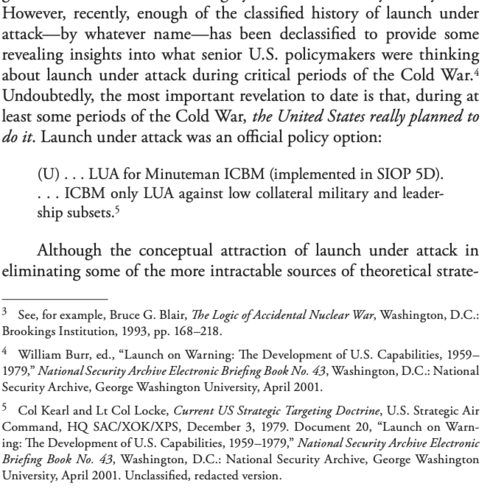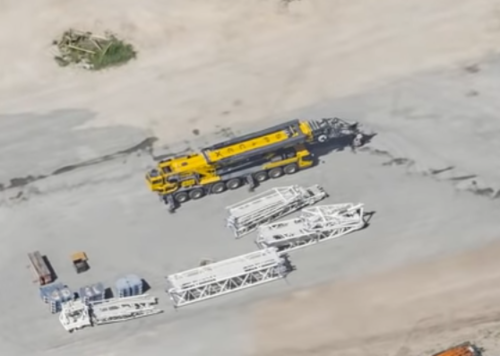That's much less than that of contemporary RV.s.
US ones perhaps, not Soviet ones. Contemporary UR-100 was 1.4km IIRC.
The point is: FOBS wasn't the solution for countering the the geometric shadow and hardened target problem.
FOBS absolutely
was a "solution for countering the geometric shadow...problem". It's not like this debate is hard to find, it's in one of the earliest reports on the Golden Arrow/MX efforts and in pretty much every report on the MX that followed. Here's one from 1983's "
Strategic Forces Technical Assessment Review":
Development of submarine-launched ballistic missiles with hard target kill capabilities which launch from non-northerly directions, accurate
fractional orbital ballistic systems, or manoeuvring reentry vehicles..."
The well-named "
ICBM Basing Options: A Summary Of Major Studies To Define A Survivable Basing Concept For ICBMs", nicely summarizes this:
The chief difficulties with this intuitively attractive concept are its poor survivability against credible advances in Soviet threats and the surprising scarcity of suitable sites. The threats include SLBMs launched from the south, maneuvering reentry vehicles and attacks of the mesas, cliffs, etc., to bury the silos in debris, thereby precluding launch.
FOBS is low-beta because it's decelerating immediately prior to terminal, which allows it to drop in at higher angles.
Now it is true that FOBS was not a solution to the hardened target problem, but the only one that has claimed that is you.
Only very accurate SLBMs or ICBMs with MaRVs could quickly service that target set.
FOBS flew a shorter path than a normal ICBM.
The Russians being chased from the open oceans into bastions meant the only fast-time threat was ICBMs with advanced MaRVs.
Time-of-flight for an SLBM from Novaya Zemlya is shorter than an ICBM, and FOBS is typically a shorter path as well.
Say FOBS achieved Trident D5 like accuracies: It's a not a fast-time threat to ICBMs and even Safeguard had no trouble knocking down FOBS.
Safeguard was incapable of knocking down FOBS. It is mentioned in pretty much
every article on the topic. Here's one of the more famous,
Garvin/Bethe's SciAm article.
Note the caption on page 26. You keep speaking of "fast time" and how FOBS doesn't deliver that, but in fact that was the entire point. When early warning was based on BMEWS, FOBS left almost no time to react. The
real goal of FOBS is to compress the time/space of the command structure. Unless the US was willing to move to launch-on-warning, and they weren't, launching FOBS against the command structure was keeping everyone awake at night. This was the basis for much of the US's pressure to dismantle FOBS, which is very well recorded in the historical record.
But don't take my word for it, take the USAFs:
The Soviet Union wanted a nuclear weapon that could stage a “backdoor” strike on US soil.

www.airforcemag.com
By contrast, a weapon launched into low orbital plane would ascend on a relatively flat, depressed trajectory, level off, and never rise more than 150 miles above Earth. It thus would not clear the radar horizon until it had almost reached its target. As Soviet planners saw it, US warning time would be reduced to as few as five minutes.
Even that much warning would be available only if the incoming warhead were to come in over the Arctic. The US in the early 1960s was unprepared to detect intrusion from the south. In that case, time from detection to impact could have been only a few seconds.
The idea was that effective use of FOBS might well rob the US of its capacity to carry out a launch-under-attack counterstrike which would be possible if a Soviet attack were detected soon enough.
Not mentioned in this article was the scenario that FOBS would be used without deborbit, and instead fly up from the south to a point above the PARs and then detonate at altitude. This could cause an ionization disk below them that would render the PAR blind, and last long enough in the UHF that the follow-up RVs would not be seen until they too were descending. Garvin/Bethe touches on this in the linked article, but in a different context.
Winds over target, rain over target, all sorts of things can change in that time.
As you can see in the diagram in Garvin/Bethe, on a direct-approach trajectory (as illustrated), FOBS spends
less time in the atmosphere. It does a pull-down/deorbit just prior to terminal. In terms of
theoretical performance, FOBS is higher.
The crucial difference is that Safeguard could be reactivated
FOBS was decommed in 1983. Safeguard was decommed in 1976 and sealed in 1977 with all the equipment removed. This is well recorded in the historical record:
The Defense Department had wanted to keep the site in a standby status after next July, with the idea that it could be reopened in an emergency. The House Appropriations Committee replied that in the ballistic missile age “the time necessary for this may simply not be available.”
They said "no" and removed any budget needed if it was ever able to be recommissioned. The guts were carted away and scrapped. Along with MAR's guts, they did see some secondary use in radio astronomy, so not a complete loss.
I've shown that FOBS was not a threat to the MMI through MMIII silos.
Which no one argued in the first place, so... what?
Despite your considered view that it FOBS was some ABM-proof, bolt-from-the-blue, hard-target killer the
Not one person has suggested this except for you.
Your claim was that FOBS induced costly force structure, procurement and operational changes for the US.
I cannot find any such statement in any posts. The closest statement is from me, which is that the US abandoned reverse inclination basing due to FOBS and SLBM. But they never operated it. So again, you're arguing against your own claims.
But on the force structure side of things, it's trivially easy to find that Sentinel was modified with south-facing PARs specifically to counter FOBS: "
A History of the Huntsville Division, 15 October 1967 - 31 December 1976". I don't know how costly that would have been, but larger than zero in any event.
FOBS was not a threat to the contemporary silos or withdraw it.
This claim was never made.
Curious: do you argue with yourself a
lot?



